Use 'Print preview' to check the number of pages and printer settings.
Print functionality varies between browsers.
Printable page generated Friday, 21 November 2025, 4:54 PM
Working with Pupils: A Guide for Teachers
Contents
About this guide
This guide aims to support teachers to use TESSA materials and activities in their classrooms.
TESSA materials enhance and improve teaching and focus on developing teachers’ classroom practice in the key curriculum areas of literacy, numeracy, science, social studies/ arts, and life skills.
1 Where can TESSA fit into your curriculum?
TESSA materials aim to enhance and improve teaching. They focus on developing teachers’ classroom practice in the key curriculum areas of literacy, numeracy, science, social studies/ arts, and life skills. The TESSA materials are all ‘Open Educational Resources’ (OERs), this means these materials can be freely downloaded, adapted, translated and integrated with other materials at no cost.
There are seventy-five sections organised in three modules in each of the five module areas shown in Table 1 below. More detail on the content of each module is found on the TESSA website by clicking on ‘Getting Started’ in the left-hand navigation bar, and then clicking on ‘Curriculum Overview’.
‘Key Resources’ can also be found on the TESSA website under your country area. These include ideas for teaching techniques such as brainstorming as well as advice on how to cope with specific issues like large classes.
| Module area | Module 1 | Module 2 | Module 3 |
|---|---|---|---|
| Literacy | Reading and writing for a range of purposes | Using community voices in the classroom | Promoting communication in an additional language |
| Numeracy | Investigating number and pattern | Exploring shape and space | Investigating measurement and data handling |
| Science | Looking at life | Investigating materials | Energy and movement |
| Social Studies and the arts | Developing an understanding of place | Investigating history | Looking at the arts |
| Life skills | Personal development | Exploring social development | Community issues and citizenship |
Before starting to use the TESSA materials we suggest you print out one section to look at whilst reading this explanation.
You will see that a section contains:
- learning outcomes (these are for you, the teacher, and show the skills and knowledge you are expected to develop during these activities)
- activities (for you to do in the classroom with your pupils)
- case studies (describing how other teachers have done this activity or a similar activity)
- resources (these are to help you use the activities with your pupils)
TESSA Snapshot: TESSA literacy module use in Kenya
|
Mrs Jenestar Wanjiru, an upper primary school teacher in Kenya, realised that her learners were not performing well in creative writing. ‘After going through the TESSA Literacy Module 1 Section 5: Ways of Becoming a Critical Reader and Writer, I found a suitable solution and tried it. It’s working.’ |
The following steps are recommended for selecting and preparing to use TESSA activities in the curriculum:
Select an appropriate theme and topic from your curriculum/scheme of work for the next few weeks – this might be one which you find particularly challenging to teach, one which your learners have struggled with or a new way of teaching that you want to try out. (Some important active teaching and learning methods and skills are given on p. 12).
Locate and review relevant TESSA materials to identify suitable sections which match your chosen theme, topic or skill. You might find it helpful to look at the TESSA Curriculum Summaries.
Ask yourself what you as a teacher have planned to achieve through teaching your theme and topic.
Read the TESSA activities and related case studies and resources.
Select the relevant TESSA activities or case studies that match what you planned to achieve. Find the resources you need (Section 2, "How can you prepare TESSA materials for your school context?").
Adapt the TESSA activities to suit your pupils and your surroundings (Section 3, "How can you teach using the TESSA materials?").
Some of the things you will need to consider are:
- the prior knowledge and experiences of your pupils
- the number of pupils in your class
- the availability of equipment and the length of your lesson
- the language level of your pupils.
- Develop your lesson accordingly including the TESSA activities and remember to include all the vital items of a lesson plan (Section 4, "How can you teach using the TESSA materials?").
 |
2 How can you prepare to use TESSA materials for your school context?
The TESSA activities encourage the use of locally available resources. A good starting point for preparing to use TESSA materials is to find out what resources you already have in your classroom, elsewhere in the school and also in your local community. Also important here is what resources your pupils would have access to at home and in the local community.
For more information go to the Key Resource: Using the local community/ environment as a resource. You can find this by clicking on your country area and then clicking on ‘Key resources’ in the left-hand menu.
TESSA Snapshot: Using local resources
|
Mrs Bibi, a teacher in Mauritius, made a scale using a clothes hanger, rope and plastic plates to demonstrate comparative terms, in this case, heavy and light. | 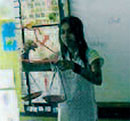 | |
It won’t always be easy to use new materials and ideas because you may need to share what TESSA is about before introducing something new into the school. See Section 7. Why and how you can share TESSA?
TESSA Snapshot: Inspiring a class visit
|
Mr Kakande Ayasi from Wairaka primary school in Uganda was working with a primary 7 class in Social Studies on global warming. He organised the seventy pupils into groups of five and used TESSA materials to stimulate discussion and to enable pupils to answer questions on global warming. The activity aroused pupils’ interest and they proposed an excursion to local factories (Kakira sugar works) to see the impact on their local environment. Mr Ayasi is enthusiastic about the TESSA materials, finding the activities drew on and enhanced the real experiences of pupils. But he comments that using them is time consuming; for example, time is needed for preparation for the excursions – surveying, seeking permission from authorities and booking the visit. |
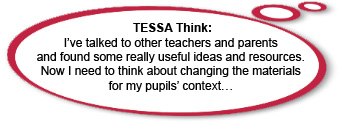 |
3 How can you adapt TESSA materials to use in your lesson plans?
The TESSA activities you have identified as suitable for your lesson will probably require changes to suit your context such as language, grade level, local culture, available resources, teaching strategy and so on. You might find that you only need to make simple changes, such as place names, or you may find that you have to make more substantial changes.
TESSA Snapshot: Translating the TESSA materials
|
Mrs Paulina Nghikembua, a teacher in Namibia, wanted to teach a literacy lesson in Oshindonga but could not find any TESSA materials in that language. So Mrs Nghikembua selected the TESSA activity from Literacy Module 1 that she wanted to do, from the materials available in English, and then translated the parts of the activity that pupils would use in Oshindonga. |
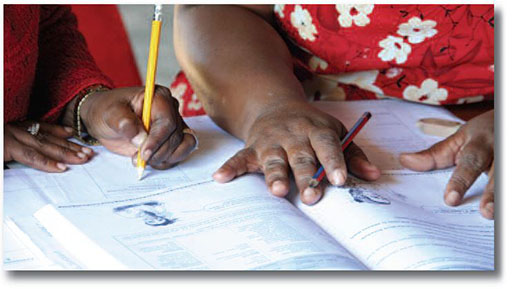
TESSA Snapshot: Adapting TESSA materials
|
Miss Gail Mulabita, a teacher in South Africa, wanted to use Resource 2 from Literacy Module 3, Section 1: Providing Natural Contexts for Language Practice for her grade 8 class. However, she found the level of language used in Resource 2 not suitable for her grade 8 pupils, as Miss Mulabita points out ‘the lesson would have been too easy’. So Miss Mulabita adapted the resource in two ways: she changed the language used in the resource and instead of the activity requiring the pupils to read and follow a set recipe, she asked her pupils to create imaginary recipes in pairs and write them down themselves. |
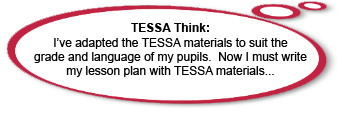 |
4 How can you teach using the TESSA materials?
The TESSA materials promote interaction and offer ideas for innovative teaching in your classroom to help your pupils’ learning.
Once you have selected and adapted the appropriate TESSA materials, concentrate on the following:
- planning your lesson
- teaching methods
- classroom management
- time management
- assessing pupils’ learning
- thinking about and improving your teaching
Planning is a continual process that helps you to think and prepare what is needed to help your pupils respond well to you and the content of what you teach.
TESSA Snapshot: Planning a lesson using TESSA materials
|
Mavis Ngini, a teacher in South Africa, was preparing a lesson where her pupils were going to create anti-litter posters based on a TESSA activity. In the previous lesson Mavis’ pupils had already assessed the level of litter on the school grounds and in the next lesson they will collect and categorise the litter for recycling or proper disposal. For her lesson today on creating posters, Mavis has to think through how much time the activity will take, what resources she will use, whether she will need any additional support, and how she will manage her class. |
For your pupils to learn from your lessons they need to be:
- interested – if they are not, nothing of any value will take place
- very clear about what you want them to do and achieve.
For further information on planning and preparing your lesson plans, go to the TESSA Key Resources in your country area of the website.
Things to think about and do before the lesson starts
- A TESSA activity can take place across more than one lesson period.
- Some lessons can take place outside the classroom, but you need to have an alternative plan should the weather change.
- It’s important to ensure you have all the resources you need at hand before the lesson starts.
- Organise your classroom to suit the activity.
- If you are using technology, have you tested that it still works?
- Before you carry out an experiment, you may want to try it yourself or with your colleagues so that you are confident when trying it out with your pupils.
The TESSA materials promote activity-based learning, however, as a teacher you need to remain involved throughout the lesson, even when your pupils are engaged in group work. For more information on using group work in your classroom, go to the Key Resources.
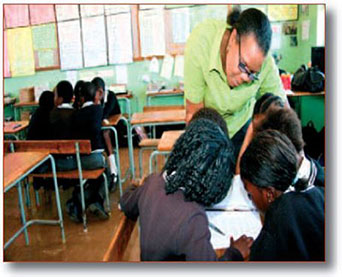
Do not panic if something in your lesson does not go according to plan. Wherever possible, during your lesson planning, create alternative activities to ensure the success of your lesson.
Things to think about and do during and after the lesson
- If you involve people from outside the school in your lessons, ensure you have an alternative plan should they not turn up.
- Ensure that your alternative plan fits in with the classroom arrangements already made.
- Should something unexpected happen just before or during the lesson:
- acknowledge the problem.
- involve the pupils in solving the problem.
- identify parts of the lesson plan that can still take place.
- Ensure that you follow up on any promises made to the class.
TESSA Snapshot: Facilitating small group work
|
Mr Obafemi Adamu, a teacher in Nigeria, divided his pupils into groups to design some posters. During this activity, Mr Adamu facilitates learning by moving around amongst the groups to answer questions, give guidance, encourage problem solving, ensure full pupil participation, and give praise, etc. |
 |
5 How does using TESSA materials contribute to pupil learning?
You can turn the TESSA activities into assessment tasks that can help you to find out whether your pupils have learned the knowledge, skills, values and attitudes described in your learning outcomes. Where this is not possible, you can develop your own assessment tool.
For more information on assessment go to the Key Resource: Assessing Learning.
Giving and receiving feedback is an important part of assessment. It is important for you to give feedback to your pupils so that you can share what they did well, what they did not do so well, and how they could improve. Remember to use this feedback to plan subsequent lessons, activities and assessment.
You should also give your pupils an opportunity to give feedback on the assessment task so that you can find out whether they thought the assessment task was appropriate/not appropriate, easy/difficult, and any problems they may have encountered.
TESSA Snapshot: Reviewing and amending assessment approach
|
Mrs Jessica Onyango, a teacher in Ghana, was disappointed with her pupils’ performance in the assessment task. She reviewed their written responses and realised that many pupils had misunderstood the instructions. In her next lesson, Mrs Onyango gave feedback to her pupils explaining that they had misunderstood the task because they had not paid sufficient attention to reading the instructions clearly. Mrs Onyango now wanted them to go through the assessment task before they started and underline all the action words, for example, ‘describe’, ‘explain’, ‘name’ and ‘list’, so that next time they would be clearer about the tasks they needed to undertake in the assessment. The next time Mrs Onyango assessed her pupils’ learning she gave her pupils time to read the whole task and underline all the action words before beginning the assessment. |
 |
6 What do you think you learned from teaching with TESSA materials?
You should reflect on your lessons to determine what worked well, and what did not work well so as to improve your teaching, and plan better subsequent lessons. In doing this, some of the questions you could consider are:
- What challenges did I have while planning and preparing for this lesson?
- How did the pupils respond to the activities (participation, interest, excitement …)?
- What did my pupils learn and how do I know this?
- Were there differences in what they learned?
- Were the outcomes of the lesson achieved?
- What was I pleased about?
- What surprised me?
- What, if anything, was disappointing?
- What difficulties were there in teaching the topic?
- Was there enough time to do the activities?
- Were the resources used appropriate and adequate?
Now you have responded to these questions, how do you feel about the activity and the way in which you use it?
TESSA Snapshot: Preparing reflective reports
Teachers registered for a professional development course titled ‘Languages and Literacies’ were asked to prepare a reflective report on a classroom activity in which they used the beginning of a traditional story to promote speaking, listening, writing and reading. Thandi Nkosi did not really know what she was expected to prepare. She wrote a draft report in which she described how she introduced the story, what she asked pupils to do with it and what they did. Thandi then contacted her tutor, explaining that she was not sure whether she had prepared her report correctly and asking for some feedback. When her tutor read the report, she realised that Thandi did not really understand what it means to write reflectively when reporting on a classroom activity. Before giving her some feedback, the tutor raised Thandi’s difficulties at a meeting of all staff involved in the Languages and Literacies course. The coordinator suggested that everyone at the meeting write brief notes on what they expected to find in a reflective report and then share their notes with the meeting. While each tutor read out his or her notes, the coordinator prepared a summary on the chalkboard. The group realised that they had not given the teachers sufficient guidelines for writing reflectively. They worked together to turn the summary into a set of instructions and questions that teachers could use in reporting reflectively on many classroom activities. This is what the instructions and questions looked like: |
Instructions and questions for teachers to use when preparing a reflective report on a classroom activity
- Write a brief description of what you [the teacher] did and what the pupils did during the activity.
- What were you pleased about?
- What, if anything, disappointed you?
- What surprised you?
- What did the pupils learn? Were there differences in what they learned?
- What did you learn from the experience of using this activity with your pupils?
- Now that you have responded to these questions, how do you feel about the activity and the way in which you used it?
 |
7 Why and how can you share TESSA?
The following case study details why and how a teacher in Tanzania, Miss Peliwe Bahame, shared TESSA with colleagues in her school, perhaps you can do the same.
TESSA Snapshot: Sharing across the school
When Miss Peliwe Bahame, a teacher from Tanzania, returned from a TESSA workshop, she immediately shared these exciting materials that provided her with activity-based learning resources, with her school leadership and members of staff. Having used TESSA materials in her lessons, Miss Bahame wanted to share some of her adapted activities with TESSA users in Tanzania, so she exchanges ideas and lessons by e-mails and phone messages with colleagues in other areas of Tanzania. |
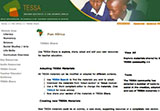 |
Miss Bahame was also interested to know what other teachers’ experiences were for using TESSA activities in their lessons. She therefore really looks forward to meeting colleagues from neighbouring schools at the weekly TESSA club organised at the local teacher centre. |
You may want to share TESSA with:
- Your school leadership;
- Your colleagues in your school;
- Teachers in other schools;
- Friends;
- Student teachers;
- District education officials.
Teaching and learning methods
Table 2 below shows some important active teaching and learning methods and some of the skills that you will need to use as a teacher.
| S/N | Active teaching and learning method | Some of the teaching skills you need |
|---|---|---|
| 1. | Building models |
Thinking about what your pupils will learn. Being able to build the model yourself. |
| 2. | Classification | Using observation. |
| 3. | Collaborative activities | Knowing your pupils, to enable you to decide on working groups. |
| 4. | Debate | Giving all pupils an opportunity to participate. |
| 5. | Demonstration |
Identifying what materials you will use to demonstrate. Allowing pupils to handle, draw and discuss. |
| 6. | Discussion | Giving all pupils an opportunity to participate. |
| 7. | Displaying real items (exhibitions) |
Organising your classroom or exhibition space. Thinking how pupils can share their knowledge, e.g. labels. |
| 8. | Games |
Thinking about what your pupils will learn. Being able to play the game yourself. |
| 9. | Group work |
Arranging your classroom in advance. Deciding how to divide your pupils. Deciding on a job for each pupil in the group. |
| 10. | Investigation/inquiry |
Planning the investigation/inquiry with your pupils. Deciding how pupils will report. |
| 11. | Making deductions | Helping pupils to discover for themselves. |
| 12. | Mind mapping/ brainstorming |
Identifying clearly the issue or problem. Letting pupils know the rules. Giving a clear summary at the end. |
| 13. | Observation/ identification |
Using local resources. Using questioning. |
| 14. | Prediction | Helping pupils form appropriate questions. |
| 15. | Problem solving |
Setting out the problem clearly. Identifying in advance areas of difficulty. Thinking of questions which will help pupils. |
| 16. | Project method |
Using group work. Helping pupils discover and think for themselves. |
| 17. | Questioning |
Thinking about the type of question – open or closed. Encouraging a range of pupils to answer. Encouraging pupils to think for themselves. |
| 18. | Reporting/oral presentation | Using a variety of ways – oral, posters, etc. |
| 19. | Researching/exploration |
Defining the research question. Deciding on the research method. Deciding on how the findings will be recorded. |
| 20. | Role play |
Using group work to act out a situation. Thinking about where the groups will work – inside or outside of the classroom. |
| 21. | Simulation | Giving pupils a clear brief. |
| 22. | Story telling/folk tales |
Identifying where you can find local and other stories. Using different people to tell stories – you, pupils and local people. |
| 23. | Student field work |
Planning. Setting clear learning objectives for pupils. Using investigations. |
| 24. | Think–pair–share | Using good time management. |
Glossary
- Assessment:
- Finding out what pupils have learned and using this knowledge to help you plan the next step in their learning. You can use TESSA materials as assessment activities.
- Formative assessment is finding out whether pupils are learning the knowledge and skills you want them to by asking questions as you go along and showing pupils how they can improve.
- Summative assessment is usually done in the form of tests and marks and gives a pupil a grade at the end of a unit of work.
- Attitudes:
- How a person or group of people thinks about an issue. Attitudes can be positive or negative.
- Classroom management:
- Organising and running your classroom to support the learning of all the pupils in your class.
- Community:
- People who live, work or study together. Your school community includes the pupils, teachers, head teacher and parents. Everyone who uses TESSA materials is another community.
- Curriculum:
- The knowledge, understanding, skills and attitudes that you teach your pupils. TESSA materials help you to teach this curriculum to your pupils.
- Facilitating learning:
- Good teachers facilitate or guide the learning of their pupils and build their understanding. Good teachers are not limited to passing on information. A teacher would help pupils to actively participate in class, they might do this by moving around and assisting groups of pupils rather than standing at the front of the classroom.
- Feedback:
- You give pupils feedback by telling them what they have done well or how to improve. Pupils can give you feedback on a lesson.
- Grade level:
- The educational level of a pupil or group of pupils.
- Group work:
- Organising pupils into smaller groups ( from 3–12 pupils) to work together on a task.
- Knowledge:
- What is known about a particular topic – the facts and information.
- Learner profile:
- The characteristics that describe what a pupil is like, knowing your pupils’ profiles can help you adapt TESSA materials for your class.
- Learning outcomes:
- These say what skills and knowledge a learner (pupil or teacher) is expected to learn at the end of a lesson or set of activities.
- Local context:
- The circumstances of your school – the type of area (rural, urban) and culture of the local community.
- Mediating learning:
- This is improving your pupils’ learning by constructing the activities and situations which are relevant to them and their interests and needs. Making it easier for a pupil to learn by presenting information in a way that they can understand.
- Reflection:
- Thinking about your experience of teaching; which lessons and activities have gone well or badly? This helps you improve future lessons.
- Reinforcing learning:
- Improving your pupils’ learning by using several different sorts of activities all on the same topic. Helping a pupil to learn and remember something by using incentives to encourage them.
- Resources:
- The equipment and materials you need for your lessons – this might include TESSA materials, books, pens, other people and local materials such as boxes, newspapers and food containers. You can use resources to help you teach and your pupils learn.